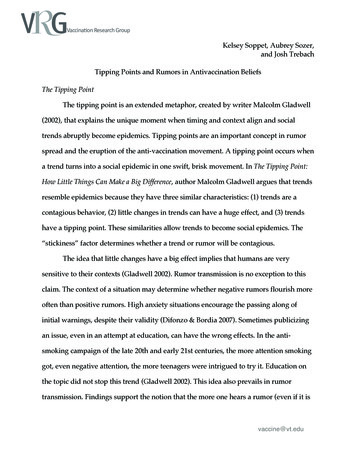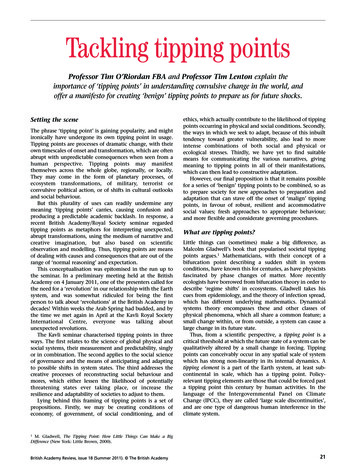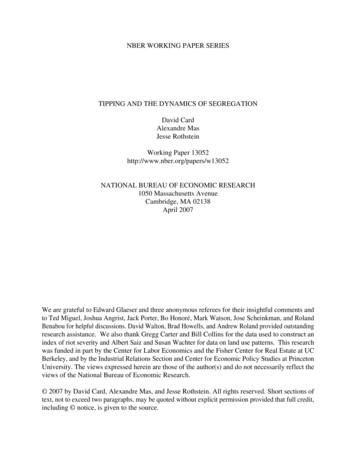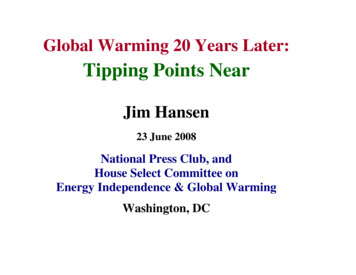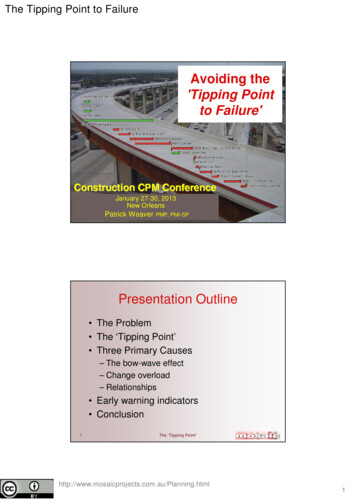
Transcription
The Tipping Point to FailureAvoiding the'Tipping Pointto Failure'January 27-30, 2013New Orleans1Patrick WeaverPMP,PMI-SPThe ‘TippingPoint’Presentation Outline The Problem The ‘Tipping Point’ Three Primary Causes– The bow-wave effect– Change overload– Relationships Early warning indicators Conclusion2The ‘Tipping html1
The Tipping Point to FailureHave you ever noticed? All projects usually start out OKMost projects continue for a while OKSome projects actually finish OKOthers suddenly crash!This paper looks at why:– Most crashes are unexpected– The consequences are severe– Recovery is very difficult3The ‘Tipping Point’The ‘Tipping Point’ Very few projects slide elegantly intofailure: You have some control in a steady slide4The ‘Tipping html2
The Tipping Point to FailureThe ‘Tipping Point’ Most projects fall off a cliff:5The ‘Tipping Point’The ‘Tipping Point’ And you have no control once you are overthe edge:6The ‘Tipping html3
The Tipping Point to FailureThe ‘Tipping Point’ The Tipping Point is a construct withinComplexity Theory. It:– Describes the way natural systems canabsorb influences with minimal (orpredictable) change until the ‘tipping point’is reached and then there is a suddencatastrophic change.– The ‘tipping point’ cannot be predicted inadvanceSee: A Simple View of ‘Complexity’ in Project es Papers 070.html7The ‘Tipping Point’The ‘Tipping Point’ The Tipping Point:– Once a system has ‘tipped’ the change isirreversible– Experience of similar systems ‘tipping’provide an indication of what to expect– But it is never the same twice! Malcolm Gladwell’s book:8The ‘Tipping html4
The Tipping Point to FailureThe ‘Tipping Point’ Project teams are ‘complex adaptivesystems’ that function by communicating The ‘team’ includes:– Client / end user– Designers and specifies– External agencies / authorities / seniormanagement– The core ‘workers’ and managers– Suppliers and subcontractors9The ‘Tipping Point’The ‘Tipping Point’ CRPR, the Complex Responsive Processof Relating. Successful teams:– Use information exchange within relationshipsto create the knowledge needed to fulfill theirobjectives– Social Capital of the team: Existing knowledge of each individual Effectiveness of the relationships (communication) Ability to process new information to create newknowledge Willingness to create and use the new knowhow10The ‘Tipping html5
The Tipping Point to FailureThe ‘Tipping Point’ Teams can adapt to change– Change and stress can strengthen teams– All teams can absorb some levels ofchange and stress with limited or(predictable) damage Repair and recovery is practical– Excessive stress destroys teams The ‘tipping point’ Repairing the damage is not possible –reconstruction is needed11The ‘Tipping Point’The ‘Tipping Point’ A dysfunctional team:– Spends time fighting– Does not communicate– Does not solve problems efficiently– Does not develop the new knowledgeneeded to deliver the project efficiently– Winning is more important than doing Communication failure project failureSee: Complexity /WP1058 Complexity Theory.pdf12The ‘Tipping html6
The Tipping Point to FailureThe ‘Tipping Point’ Research into projects shows a similareffect: Pavel he ‘Tipping Point’The ‘Tipping Point’Within ‘normal’ work,the range of outcomestends to a ‘normal’distribution.After the ‘tipping point’there are extremeoutliers that ss.com/14The ‘Tipping html7
The Tipping Point to FailureThe ‘Tipping Point’ Research into projects shows a similareffect: The Helmsman complexity cliffWhen complexityincreases beyond theorganization's capabilitythe performancedecreases significantlyThis applies to both- The organisation- And the project!15The ‘Tipping Point’The ‘Tipping Point’Two basic facts:1 Once a system has tipped it can nevergo back to its original state!2 You cannot predict the tipping point inadvance– But you can recognize similar trends andpatterns to know one is approaching16The ‘Tipping html8
The Tipping Point to FailureProject Complexity There are four basic dimensions toevery project:– Its inherent size;– The degree of technical difficulty increating the output (complication);– The degree of uncertainty involved in theproject; and– The complexity of the relationships bothwithin the project team (‘small p’ politics)and surrounding the project.17The ‘Tipping Point’Project Complexity In combination these create the innate‘complexity quotient’ for the project The innate complexity of the projectshould be compensated by the skills ofthe project organisation and the team The Helmsman model is built aroundorganisational ability to managecomplexitySee: Project Size and tePapers/WP1072 Project Size.pdf18The ‘Tipping html9
The Tipping Point to FailureHelmsmanComplexity ScaleCombines:1. Context / Stakeholder2. Social Factors3. Ambiguity4. Technical Complexity5. Project ManagementmaturityAPMG – InternationalKeith WilliamsHelmsman Institute Pty Ltd19The ‘Tipping Point’Project Complexity The ability to manage ‘complexity’ isinnate to the organisation – the locationof the ‘cliff’ depends on theorganisational capabilities Assuming the initial project, theorganisational capabilities and the teamdesign are balanced 20The ‘Tipping html10
The Tipping Point to FailureProject Complexity Most project teams can manage a ‘bitmore’ complexity caused by the actionsof others in the ‘team’ Until the ‘tipping point’ is reached This is the space where project controlsystems add value! Three basic sources of ‘addedcomplexity’ are:21The ‘Tipping Point’Cause 1 Burning contingencies too quickly– Caused by inadequate output– Consuming float and delaying non-criticalwork– Over consuming calculated riskmanagement contingencies– Frequently hidden (end dates are ‘OK’)– Tipping point: Sudden massive increase inoutput required when the project ‘hits thewall’ but no spare capacity22The ‘Tipping html11
The Tipping Point to FailureCause 2 Excessive change– Change orders / changing requirements– Changes in strategy– Changes in project team (eg, suppliers)– Under control, changes incorporated andcommunicated in a timely manner– Tipping point: changes not incorporated Rework and delay – late communication Changes to changes to fix issues23The ‘Tipping Point’Cause 3 Failing relationships– Inefficient communication– Ineffective problem solving– Emergence of the ‘blame game’– In control – open communication and trust– Tipping point: All communication verified(eg, in writing) – no trust. Slow and ineffective communication Ineffective problem solving and limitedknowledge creationSee: http://www.stakeholdermapping.com/24The ‘Tipping html12
The Tipping Point to FailureCauses of a ‘Tipping Point’ All three causes interact and feed offeach other Management cannot cope with theissues and complexity Relationships fail, communicationbreaks down Project ‘tips’ into failure25The ‘Tipping Point’Causes of a ‘Tipping Point’Problems cannot be solved at thelevel of awareness that createdthem.Albert EinsteinOnce a project has tipped, the current team isincapable of reversing the problem.26The ‘Tipping html13
The Tipping Point to FailureEarly Warning Indicators Project controls can help predict theemergence of a ‘tipping point’ Timely management action to reinforcethe current team may avoid the ‘cliff’ But the indicators are subtle andprevious experience of a ‘tipping point’is essential27The ‘Tipping Point’Early Warning Indicators Productivity issues (cause 1)– Measure the consumption of ‘float’– Use Earned Schedule and TCPI(t)– Measure consumption of contingencies Solution– Identify the problem early– Identify the cause (usually management)– Take strong corrective actions early– Trust your planners and controls people!28The ‘Tipping html14
The Tipping Point to FailureEarly Warning Indicators Excessive change (cause 2)– Measure the time to resolve changes– Measure the # late changes (rework)– Measure the # open changes (trends) Solution– Understand what is ‘normal’– Identify abnormalities early– Add appropriate resources early– Work with the source of the changes29The ‘Tipping Point’Early Warning Indicators Relationship breakdown (cause 3)– Assess stakeholder relationships regularly– Plan to build robust relationships and testtheir effectiveness– Track trends: overall and key individuals Solution– Don’t let key relationships fail!– Get outside help if needed– Pre-plan escalation paths30The ‘Tipping html15
The Tipping Point to FailureEarly Warning Indicators Organisational resilience is the key:– Open and robust communication– Some spare capacity and unusedcapability– Willingness to seek help and acceptassistance– Focus on problem solving and outcomes(not the ‘blame game’)– Management prepared to make decisionsand change decisions as things emerge31The ‘Tipping Point’Dealing with Disaster Remember everyone is in the ‘sameboat’ – including the client! The current team can only ‘hold the line’ Massive support is needed quickly to:– Rebuild relationships– Determine the scale of the problem– Stop the situation getting worse (triage)– Repair the damage– Establish a new capability to finish32The ‘Tipping html16
The Tipping Point to FailureConclusions Once you have ‘tippedinto failure’ it is too late! The team that ‘tipped’cannot recover themselves Look for the warning signs and act early But the preventative action cost moneyand introduces its own complexity33The ‘Tipping Point’Conclusions Preparation is the key– Understand theorganisation’s capability– Understand the projectteam’s capability– Understand you clientscapability– Pack your parachutes .34The ‘Tipping html17
The Tipping Point to FailureConclusions Backed up by rigourous surveillanceManageableChaosThe ‘Tipping Point’35The ‘Tipping Point’Questions PleasePatrick Weaver PMPEmail: patw@mosaicprojects.com.auTel: 03 9696 8684Web: www.mosaicprojects.com.auMosaic’s Scheduling home Pagewww.mosaicprojects.com.au/Planning.html36The ‘Tipping html18
7 The 'Tipping Point' The 'Tipping Point' The Tipping Point is a construct within Complexity Theory. It: - Describes the way natural systems can absorb influences with minimal (or predictable) change until the 'tipping point' is reached and then there is a sudden catastrophic change. - The 'tipping point' cannot be .

